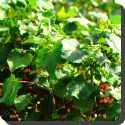 Buckwheat — Buckwheat refers to plants in two genera of the family Polygonaceae: the Eurasian genus Fagopyrum, and the North American genus Eriogonum. The crop plant, common buckwheat, is Fagopyrum esculentum. Tartary buckwheat (F. tataricum Gaertn.) or “bitter buckwheat” is also used as a crop, but it is much less common. Despite the common name and the grain-like use of the crop, buckwheats are not grasses and are not related to wheat. The agricultural weed known as Wild Buckwheat (Fallopia convolvulus) is in the same family, but not closely related to the crop species. Within Fagopyrum, the cultivated species are in the cymosum group, with F. cymosum L. (perennial buckwheat), F. giganteum and F. homotropicum. The wild ancestor of common buckwheat is F. esculentum ssp.ancestrale. F. homotropicum is interfertile with F. esculentum and the wild forms have a common distribution, in Yunan. The wild ancestor of tartary buckwheat is “F. tataricum ssp. potanini.
Buckwheat — Buckwheat refers to plants in two genera of the family Polygonaceae: the Eurasian genus Fagopyrum, and the North American genus Eriogonum. The crop plant, common buckwheat, is Fagopyrum esculentum. Tartary buckwheat (F. tataricum Gaertn.) or “bitter buckwheat” is also used as a crop, but it is much less common. Despite the common name and the grain-like use of the crop, buckwheats are not grasses and are not related to wheat. The agricultural weed known as Wild Buckwheat (Fallopia convolvulus) is in the same family, but not closely related to the crop species. Within Fagopyrum, the cultivated species are in the cymosum group, with F. cymosum L. (perennial buckwheat), F. giganteum and F. homotropicum. The wild ancestor of common buckwheat is F. esculentum ssp.ancestrale. F. homotropicum is interfertile with F. esculentum and the wild forms have a common distribution, in Yunan. The wild ancestor of tartary buckwheat is “F. tataricum ssp. potanini.
Common buckwheat was domesticated and first cultivated in southeast Asia, possibly around 6000 BC, and from there spread to Europe and to Central Asia and Tibet. Domestication most likely took place in the western Yunnan region of China. Buckwheat is documented in Europe in the Balkans by at least the Middle Neolithic (circa 4000 BC) and the oldest known remains in China so far date to circa 2600 BC, and buckwheat pollen has been found in Japan from as early as 4000 BC. It is the world’s highest elevation domesticate, being cultivated in Yunnan on the edge of the Tibetan Plateau or on the Plateau itself. Buckwheat was one of the earliest crops introduced by Europeans to North America. Dispersal around the globe was complete by 2006, when a variety developed in Canada was widely planted in China.
 Kids Portal For Parents India Kids Network
Kids Portal For Parents India Kids Network






